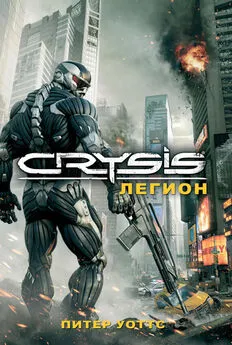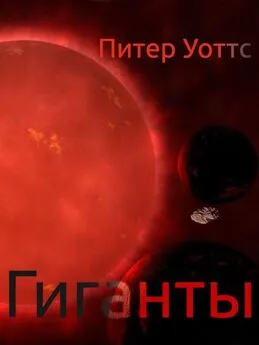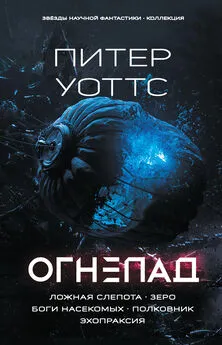Питер Уоттс - Эхопраксия
- Название:Эхопраксия
- Автор:
- Жанр:
- Издательство:АСТ
- Год:2015
- Город:Москва
- ISBN:978-5-17-089361-4
- Рейтинг:
- Избранное:Добавить в избранное
-
Отзывы:
-
Ваша оценка:
Питер Уоттс - Эхопраксия краткое содержание
Эхопраксия - читать онлайн бесплатно ознакомительный отрывок
Интервал:
Закладка:
31
Здесь имеется в виду открытие генов, кодирующих кадгерины — белки, отвечающие за межклеточное взаимодействие, у одноклеточных простейших, в частности жгутикового Monosiga brevicollis, относящегося к классу хоанофлагеллатов. Именно эти белки позволили потомкам Monosiga впоследствии объединяться в колонии, а потом и взаимодействовать друг с другом, став основой чего-то вроде нервной системы.
32
D. М. Rosenthal, "Consciousness and Its Function", Neuropsychologia 46. no. 3 (2008): 829, 840.
33
Asael Y. Sklaret al., "Reading and Doing Arithmetic Nonconsciously", Proceedings of the National Academy of Sciences (November 12, 2012): 201211645, doi: 10.1073/pnas. 1211645109.
34
Ap Dijksterhuis et al., "On Making the Right Choice: The Deliberation Without-Attention Effect", Science 311, no. 5763 (February 17, 2006): 1005–1007, doi: 10.1126/science. 1121629.
35
Christof Koch and Naotsugu Tsuchiya, "Attention and Consciousness: Two Distinct Brain Processes", Trends in Cognitive Sciences 11, no. 1 (January 2007): 16–22. doi:I0.!016/j.tics.2006.10.012.
36
Ken A. Paller and Joel L. \foss, "An Electrophysiological Signature of Unconscious Recognition Memory, Nature Neuroscience" 12, no. 3 (March 2009): 349+.
37
C. Nathan DeW&U, Roy F. Baumeister, and E. J. Masicampo, "Evidence That Logical Reasoning Depends on Conscious Processing", Consciousness and Cognition 17, no. 3 (September 2008): 628–645, doi: 10.1016/j.concog.2007.12.004.
38
Ezequiel Morsella et al., "The Essence of Conscious Conflict: Subjective Effects of Sustaining Incompatible Intentions", Emotion (Washington, D. C.) 9, no. 5 (October 2009): 717–728, doi: 10.1037/a0017121.
39
E. Morsella, "The Function of Phenomenal States: Supramodular Interaction Theory", Psychological Review 112, no. 4 (2005): 1000–1021.
40
Matthew W. Self and Pieter R. Roelfsema, "Optogenetics: Eye Movements at Light Speed", Current Biology 22, no. 18 (September 25, 2012): R8047R806, doi:10.1016/j.cub.2012.07.039.
41
Shahar Arzy et al., "Induction of an Illusory Shadow Person", Nature 443, no. 7109 (September 21, 2006): 287–287, doi:10.1038/443287a.
42
Michael A. Persinger and Sandra G. Tiller, "Case Report: A Prototypical Spontaneous ‘sensed Presence’ of a Sentient Being and Concomitant Electroencephalographic Activity in the Clinical Laboratory", Neurocase 14, no. 5 (2008): 425–430, doi:10.1080/13554790802406172.
43
Joyce Cohen, "For People With Misophonia, a Chomp or a Slurp May Cause Rage". June 9, 2011, http://www.nytimes.com/2011/09/06/health/ 06annoy.html.
44
Rachel Jones. "Stress Brings Memories to the Fore", PLoS Biol 8, no. 12 (December21. 2010): el001007, doi:10.1371/joumal.pbio.l001007.
45
V. S. Ramachandran, The Tell-tale Brain: a Neuroscientist’s Quest for What Makes Us Human (NY: W. W. Norton, 2012). Русское издание: Рамачандран В. Мозг рассказывает. Что делает нас людьми. М.: Карьера Пресс, 2015.
46
Alexis С. Madrigal, "The Dark Side of the Placebo Effect: When Intense Belief Kills", The Atlantic, September 14, 2011, http://www.theatlantic.com/health/archive/2011/09/the-dark-side-of-the-placebo-effectwhen-intense-belief-kills/245065/.
47
Vilayanur S. Ramachandran and Sandra Blakeslee, Phantoms in the Brain (New York: Quill, 1999).
48
Mark Brown, "How the Brain Spots Faces?" Wired Science, Wired ~nence. January 10, 2012, http://www.wired.com/wiredscience/2012/0l/n-£ace-recognition/.
49
Simon Lacey, Randall Stilla, and К. Sathian, "Metaphorically Feeling: Comprehending Textural Metaphors Activates Somatosensory Cortex", Brain and Language 120, no. 3 (March 2012): 416–421, doi:10.1016/j.bandl. 2011-12.016.
50
FizerPharm, Inc. "Vampire Domestication: Taming Yesterday’s Nightmares for a Better Tomorrow" 2055. http://www.rifters.com/blind-sight/vampires.htm.
51
Patricia Bianco-Arias, Carole A. Sargent, and Nabeel A. Affara, "А Comparative Analysis of the Pig, Mouse, and Human PCDHX Genes", Mammalian Genome: Official Journal of the International Mammalian Genome Society 15, no. 4 (April 2004): 296–306, doi:10.1007/s00335-003-3034-9.
52
Alexey Cheberda, Janna Randina, and J. Random, "Coincident Autapomorphies in the Y-PCDHX Y-PCDHY Gene Complexes and Their Role in Yhmpire Hominovory", Vampire Genetics and Epigenetics 24, no. 1 (2072): 435–460.
53
Anonymous, "Philosophical Zombie", Wikipedia, the Free Encyclopedia. October 25, 2013, http://en.wikipedia.org/w/index.php?title= Philosophical — zombie&oldid=576098290.
54
22 Giulio Tononi and Gerald M. Edelman, "Consciousness and Complexity". Science 282, no. 5395 (December 4, 1998). 1846 1851, doi: 10.1126/science. 282.5395.1846.
55
Jaakko W. Langsjo et al., "Returning from Oblivion: Imaging the Neural Core of Consciousness", The Journal of Neuroscience 32, no. 14 (April 4. 2012): 4935–4943, doi:10.1523/JNEUROSCI.4962-l 1.2012.
56
Navindra Persaud et al., "Awareness-related Activity in Prefrontal and Parietal Cortices in Blindsight Reflects More Than Superior Visual Performance", Seurolmage 58, no. 2 (September 15, 2011): 605–611, doi: 10.1016/j.neuroimage.2011.06.081.
57
Franco Cauda et al., "Functional Anatomy of Cortical Areas Characterized by \bn Economo Neurons", Brain Structure and Function 218, n0. l (January 29, 2012): 1-20, doi:10.1007/s00429-012-0382-9.
58
Caroline Williams, "The Cells That Make You Conscious", New Scientist 215, no. 2874 (July 21, 2012): 32–35, doi:10.1016/S0262-4079(12) 61884-3.
59
Adrian Raine, Monte Buchsbaum, and Lori Lacasse, "Brain Abnormalities in Murderers Indicated by Positron Emission Tomography", Biological Psychiatry 42, no. 6 (September 15, 1997): 495–508, doi.10.1016/ s0006-3223(96)00362-9.
60
Duane Р. Harland and Robert R. Jackson, "Eight-legged Cats and How They See — a Review of Recent Research on Jumping Spiders (Araneae: Salticidae). 16 (2000): 231–240, Cimbebasia 16 (2000): 231240.
61
D. P. Harland and R. R. Jackson, "А Knife in the Back: Use of Prey. Specific Attack Tactics by Araneophagic Jumping Spiders (Araneae: Salticidae). Journal of Zoology 269, no. 3 (2006): 285–290,
doi:10.1111/j-1469-7998.2006.00112.x.
62
M. Tarsitano, "Araneophagic Jumping Spiders Discriminate Between Detour Routes That Do and Do Not Lead to Prey, Animal Behaviour 53, no. 2(n. d): 257–266.
63
John McCrone, "Smarter Than the Average Bug, blew Scientist 191, no. 2553 (2006): 37+.
64
H N. Miras et al., "Unveiling the Transient Template in the SelfAssembly of a Molecular Oxide Nanowheel, Science 327, no. 5961 (December 31.2009): 72–74, doi: 10.1126/science. 1181735.
65
Katharine Sanderson, "Life in 5000 Hours: Recreating Evolution in the Lab, New Scientist 209, no. 2797 (January 29, 201 1): 32–35, dot: 10.1016/S0262-4079(11)60217-0.
66
Geoffrey J. Т. Cooper, "Modular Redox-Active Inorganic Chemical Cells: iCHELLs", Angewandte Chemie International Edition 50, no. 44 (2011): 10373—10376.
67
V. N. Tsytovich, "From Plasma Crystals and Helical Structures Towards Inorganic Living Matter", New Journal of Physics 9, no. 8 (August 1, 2007): 263.
68
Ara Norenzayan and Azim F. Shariff, "The Origin and Evolution of Religious Prosociality", Science 322, no. 5898 (October 3, 2008): 58–62, doi: 10.1126/science. 1158757.
69
Richard Sosis and Candace Alcorta, "Signaling, Solidarity, and the Sacred: The Evolution of Religious Behavior", Evolutionary Anthropology: Issues, News, and Reviews 12, no. 6 (2003): 264–274, doi:10.1002/ evan. 10120.
70
Jesse M. Bering, "The Folk Psychology of Souls", Behavioral and Brain Sciences 29, no. 05 (2006): 453–462, doi:10.1017/S0140525X06009101.
71
Azim F. Shariff and Ara Norenzayan, "God Is Watching You: Priming God Concepts Increases Prosocial Behavior in an Anonymous Economic Game" Psychological Science 18, no. 9 (September 1, 2007): 803–809, doi: 10. \ 111/j. 1467–9280.2007.01983.x.
72
Melissa Bateson, Daniel Nettle, and Gilbert Roberts, "Cues of Being Whtched Enhance Cooperation in a Real-world Setting, Biology Letters 2, no 3 (September 22, 2006): 412–414, doi:10.1098/rsbl.2006.0509.
73
Azim F. SharifF and Ага Norenzayan, "Mean Gods Make Good People: Different Views of God Predict Cheating Behavior", International Journal for the Psychology of Religion 21, no. 2 (2011): 85–96, doi: 10.1080/10508619.2011.556990.
74
Jeffrey P. Schloss and Michael J. Murray, "Evolutionary Accounts of Belief in Supernatural Punishment: a Critical Review", Religion, Brain & Behavior! no. 1 (2011): 46–99, doi:10.1080/2153599X.2011.558707.
75
…и это лишь небольшая часть.
76
Eckart Voland and Wulf Schiefenhovel (Eds), The Biological Evolution of Religious Mind and Behavior, 2009, http://www.springer.com/life+sciences/evolutionary+%26+developmental+biology/book/978-3642-00127-7.
77
Justin L. Barrett, "The God Issue: Wfe Are All Bom Believers", New Scientist 213, no. 2856 (March 17, 2012): 38–41, doi: 10.1016/S02624079(12)60704-0.
78
Raul Bloom, "Is God an Accident?", The Atlantic, December 2005, http://www.theatlantic.com/magazine/archive/2005/12/is-god-an-accident/304425/?single— page=true.
79
Elizabeth Culotta, "On the Origin of Religion", Science 326, no. 5954 (November 6, 2009): 784–787, doi: 10.1126/science.326–784.
80
Dr. Robert Sapolsky?s Lecture About Biological Underpinnings of Religiosity, 2011, http://www.youtube.com/watch?v=4WwAQqWUkpI&feature=youtube^gdata — player.
81
Sam Harris et al""The Neural Correlates of Religious and Nonreligious Belief", PLoS ONE A, no. 10 (October 1, 2009): e7272, doi: 10.1371/joumal.pone.0007272.
82
Lorenza S. Colzato, Wfery Р. М. van den Wildenberg, and Bernhard Homme! "Losing the Big Picture: How Religion May Control Visual Attention", PLoS ONE 3, no. 11 (November 12, 2008): e3679, doi: 10.1371 / journal.pone.0003679.
Читать дальшеИнтервал:
Закладка:







![Питер Уоттс - Огнепад: Ложная слепота. Зеро. Боги насекомых. Полковник. Эхопраксия [сборник litres]](/books/1076601/piter-uotts-ognepad-lozhnaya-slepota-zero-bogi-na.webp)


